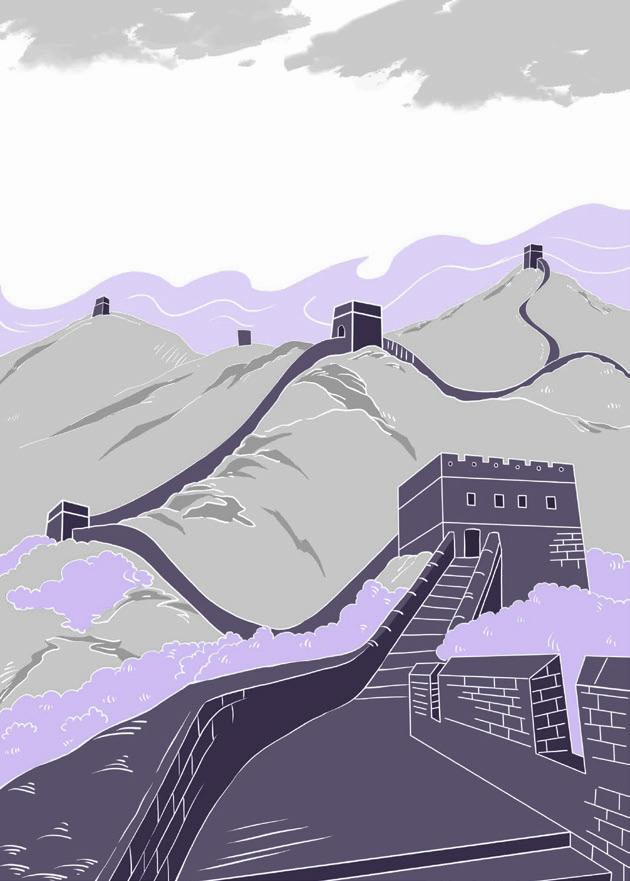长 城
2019-11-28
在发展素质教育、全面落实立德树人根本任务的今天,英语教育工作者要有意识地引导学生用英语讲述中国故事,传播中华优秀文化,为实现“培养具有中国情怀、国际视野和跨文化沟通能力的社会主义建设者和接班人”的英语课程目标而努力。《英语学习》将继续连载程晓堂教授、张祖春研究员共同主编,湖北教育出版社出版的《学英语 讲中国故事》的选篇,旨在丰富教师教学材料的同时,表达和传播中华优秀文化,培养学生的中国情怀。
本篇选自《学英语 讲中国故事——名胜古迹篇》,介绍了我国名胜古迹的代表之一——长城。中国是世界上最古老的文明国家之一,名胜古迹众多。我们漫步在名山大川之中,既可以领略祖国的大好河山,也可以从中感悟祖国悠久灿烂的历史文化。

With a history of more than 2,000 years, the Great Wall of China is one of the greatest wonders in the world. Owing to its architectural grandness1 and historic significance, it is one of the most attractive places of interest all around the world. As a result, it was listed as a World Heritage Site by UNESCO in 1987.
The Great Wall was continuously built from the 3rd century B.C. to the 17th century A.D. on the northern border of China as the great military defense project. The total length adds up to more than 20,000 kilometres. The main body of the great project consists of walls, horse tracks, watching towers, and shelters2 on the wall, and includes fortresses3 and passes along the Great Wall. The Great Wall winds up and down across deserts, grasslands, mountains and plateaus4, stretching from the east to the west of China like a huge dragon.
Construction History
The construction of the Great Wall began during the Spring and Autumn period and lasted into the Warring States period. All the states of Qin, Wei, Zhao and Yan had built hundreds of miles of walls to defend their own borders and to protect their people. These unlinked walls were the embryonic5 form of the Great Wall. In 221 B.C., the first Emperor, Qin Shi Huang ordered all the walls to be linked up and reinforced.
The Wall took on its present form during the Ming Dynasty. Already known as the Ten Thousand Li Wall at that time, it stretched about 6,300 kilometres. The early walls were made of packed earth and wood. And they were later replaced by stones and bricks. Sometimes mountain ridges were even taken directly as the body of the Wall.
Miracle in History
The Great Wall, a miracle in human history, is a treasure of Chinese civilization and is regarded as a symbol of the Chinese nation. No other ancient building in the world has been constructed for so long a time, on such a great scale and at so high a cost. Dr. Sun Yat-sen ( 孫中山) once commented that the Great Wall is the most famous work in China and a truly marvelous6 sight on earth.
The Great Wall is both a cultural relic and a natural landscape. It has been widely known among domestic and foreign tourists that there is a famous saying which goes, “One is not a true man unless he climbs up the Great Wall( 不到长城非好汉 ).”
Meng Jiangnvs Bitter Weeping
There are many legends and stories about the Great Wall. One of the popular legends is about Meng Jiangnv. It was said that Meng Jiangnvs husband was taken by force to work on the Great Wall soon after they got married. When autumn came, Meng Jiangnv worried that her husband would suffer from the cold in the north. So she walked all the way to the construction site of the Great Wall, taking padded7 clothes which she had made for him. But when she got there, she was told that her husband had already died from exhaustion and had been buried at the foot of the Great Wall.
Meng Jiangnv could not help crying. She sat on the ground and wept bitterly. Suddenly with tremendous noise, a 400-kilometre-long section of the Wall collapsed over her bitter weeping. Meanwhile, a pit was found containing piles of skeletons8. She couldnt identify9 her husband among them, so she threw herself into the sea together with some pieces of skeleton. Later, a temple named after Meng Jiangnv was built at the foot of the Great Wall to commemorate10 her loyalty11 to her husband. Since then, Meng Jiangnvs story has been passed down from generation to generation.

Notes
1. grandness n. 宏偉;壮大2. shelter n. 庇护所
3. fortress n. 堡垒;要塞
4. plateau n. 高原
5. embryonic form 雏形
6. marvelous adj. 非凡的
7. padded adj. 有填充物的
8. skeleton n. 骨骼;骨架
9. identify v. 识别;辨认
10. commemorate v. 纪念
11. loyalty n. 忠诚
